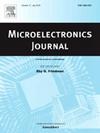A 2 MHz-BW 80.6 dB-SNDR 95.9 dB-SFDR 2nd-order noise-shaping SAR using open-loop Gm-R amplifier
IF 1.9
3区 工程技术
Q3 ENGINEERING, ELECTRICAL & ELECTRONIC
引用次数: 0
Abstract
This work presents a noise-shaping successive-approximation-register (NS-SAR) ADC employing an open-loop Gm-R amplifier. Within the adopted cascaded integrator feed-forward (EF-CIFF) architecture with sampling kT/C noise cancellation, higher speed operation is enabled by the Gm-R amplifier as it simplifies timing control and does not require gain calibration. The quantizer uses 8-bit quantization depth, which is the theoretical optimum quantitatively estimated for the targeted 80 dB signal-to-noise-distortion ratio (SNDR). Fabricated in a 28 nm CMOS process, the prototype NS-SAR ADC operating at 50 MS/s sampling rate achieves 80.6 dB SNDR over a 2 MHz bandwidth with an oversampling ratio (OSR) of 12.5. It occupies 0.026 mm with a total power consumption of 1.275 mW at 1 V supply, resulting in a Schreier figure-of-merits (FoMs) of 172.6 dB.
采用开环Gm-R放大器的2 MHz-BW 80.6 dB-SNDR 95.9 dB-SFDR二阶噪声整形SAR
本工作提出了一种采用开环Gm-R放大器的噪声整形连续逼近寄存器(NS-SAR) ADC。在采用的级联积分器前馈(EF-CIFF)架构中,采用采样kT/C噪声消除,Gm-R放大器可以实现更高的速度操作,因为它简化了定时控制,不需要增益校准。量化器采用8位量化深度,这是对目标80 dB信噪比(SNDR)的理论最佳定量估计。原型NS-SAR ADC采用28 nm CMOS工艺制作,在50 MS/s采样率下工作,在2 MHz带宽下实现80.6 dB SNDR,过采样比(OSR)为12.5。它占地0.026 mm2,在1v电源下的总功耗为1.275 mW,其Schreier性能曲线(FoMs)为172.6 dB。
本文章由计算机程序翻译,如有差异,请以英文原文为准。
求助全文
约1分钟内获得全文
求助全文
来源期刊

Microelectronics Journal
工程技术-工程:电子与电气
CiteScore
4.00
自引率
27.30%
发文量
222
审稿时长
43 days
期刊介绍:
Published since 1969, the Microelectronics Journal is an international forum for the dissemination of research and applications of microelectronic systems, circuits, and emerging technologies. Papers published in the Microelectronics Journal have undergone peer review to ensure originality, relevance, and timeliness. The journal thus provides a worldwide, regular, and comprehensive update on microelectronic circuits and systems.
The Microelectronics Journal invites papers describing significant research and applications in all of the areas listed below. Comprehensive review/survey papers covering recent developments will also be considered. The Microelectronics Journal covers circuits and systems. This topic includes but is not limited to: Analog, digital, mixed, and RF circuits and related design methodologies; Logic, architectural, and system level synthesis; Testing, design for testability, built-in self-test; Area, power, and thermal analysis and design; Mixed-domain simulation and design; Embedded systems; Non-von Neumann computing and related technologies and circuits; Design and test of high complexity systems integration; SoC, NoC, SIP, and NIP design and test; 3-D integration design and analysis; Emerging device technologies and circuits, such as FinFETs, SETs, spintronics, SFQ, MTJ, etc.
Application aspects such as signal and image processing including circuits for cryptography, sensors, and actuators including sensor networks, reliability and quality issues, and economic models are also welcome.
 求助内容:
求助内容: 应助结果提醒方式:
应助结果提醒方式:


